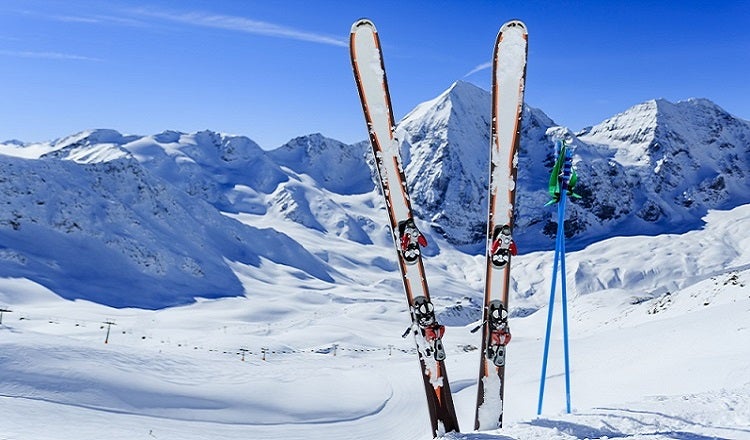
Our Editors independently research, test, and rate what we feel are the best products. We use affiliate links and may receive a small commission on purchases.
Are you ready to learn how to ski this season? Whether you’ve been putting it off or you’re just going with some friends or family, there’s no reason to wait!
As a full time instructor with years of experience, I can tell you that choosing the best beginner skis to get started can make all the difference. When I started learning to ski I had no clue what I was doing or what to buy!
I’m going to recommend a few skis here that would make great choices for beginners.
Best Skis For Beginners
For more of my ski gear recommendations, have a look through these popular Outside Pursuits guide links: Beginner Ski Boots, Ski Boot Bags, Ski Travel Bags.
Quick Answer: The 5 Best Rated Skis For Beginners
- Atomic Vantage 79 Ti Skis with Bindings
- Rossignol Experience 76 Ci/Xpress 10 Ski Package
- K2 Ikonic 84 Skis w/Marker M3 Bindings
- Rossignol Experience 88 HD Skis
- K2 iKonic 80 Skis w/ M3 10 Bindings
Now, I’ll help you figure out how to get started picking out a top rated beginner ski for you. Let’s get to it.
Beginner Ski Reviews
#1 Atomic Vantage 79 Ti Skis with Bindings
- Underfoot: 79mm
- Lengths: 156, 163, 179cm
- Directional shape
- All mountain ski
Atomic has been making skis for ages and their equipment extends all over the alpine skiing industry. This solid beginner ski is another narrow ski with features meant to live on the groomed ski runs.
A narrow waist, flat tail, and moderate turn radius make these skis another solid choice for beginner skiers. With a price that’s reasonable you’ll be able to grow into these skis for a few seasons (unless you learn really fast).
Soft flex and integrated bindings make these skis easy to turn for beginners and hassle free for setup with your new pair of boots.
Video: Overview of the Atomic Advantage skis.
Don’t hesitate to start out with a nice narrow ski as you learn to ski on the runs. It’s going to make your skiing much easier to manage.
Sometimes it’s also advisable to go a bit on the short side when choosing length for a beginner ski. Note: These are uni-sex skis.
Best For: Beginner and Intermediate skiers for powder and groomed trails.
#2 Rossignol Experience 76 Ci/Xpress 10
- Underfoot: 76mm
- Lengths: 162, 170cm
- For packed powder / groomed runs
- Paulownia wood core and carbon fiber for light weight
Rossignol’s Experience line of skis is meant to be an all mountain ski with a touch of on-piste favor-ability. These skis are a moderate 76mm under foot which means they’re narrow enough to tear up the groomers yet wide enough to float in powder and crud.
With an integrated binding system, you’ll have no problem fitting this ski to any boot and no hassle trying to pick out your own bindings.
I love that integrated bindings are becoming more popular and more refined. This makes life so much easier for beginner skiers and there’s so much less to go wrong.
Rossignol has been making great skis for years and you will find plenty of company among skiers with Rossignol equipment. It’s a great company to buy gear from!
Best For: Beginner and Intermediate groomed trail skiing
Ladies, you’ll find an equally suitable option with the Women’s Temptation 84 skis from Rossignol.
#3 K2 Ikonic 84 Skis w/Marker M3 Bindings
- Underfoot: 84mm
- Lengths: 170, 177cm
- All mountain ski
- Early rise rocker for easier turns
As a full time ski instructor, I spend more than 100 days a year on skis. For the last two years, I’ve spent every one of those days on a pair of K2 skis quite similar to these.
K2 Konic skis are made with a narrow waist which equates to high agility, aggressive turns, and great control.
At 64mm under foot this ski isn’t meant for off-piste skiing (powder skiing) but since you’re a beginner, you’ll probably be staying on the groomed runs anyways.
Flat tails and a moderate tip rocker mean that the ski has an incredibly long effective edge. Effective edge is the amount of ski which maintains contact with the snow during normal conditions.
Because of this, the ski will have good edge grip and control. I recommend this ski for the beginner looking to stay on the groomed runs.
Best For: Beginner and Intermediates skiers who want to carve some turns on groomed trails
Ladies, you’ll find an equally suitable option with the K2 Luv 88 Womens Skis.
#4 Rossignol Experience 84 Ai/SPX Skis
- Underfoot: 84mm
- Lengths: 152, 160, 168, 176, 184cm
- Directional shape
- All mountain ski
Rossi is a brand that has been around in the limelight as long as I can remember. It’s hard to displace them for a reliable beginner brand that you can count on to perform time after time.
With lengths from 152 to 184 there’s something here for just about everyone. However, smaller men and women both may struggle to find a short enough ski to stay nimble as a beginner.
That said, the 84mm waist is narrow enough to stay edgy but wide enough to take anyone off piste for some fun in the trees. While most will consider this an intermediate ski I think many beginners will find it easy enough to handle and it will make a great companion on the groomers while you learn.
The only drawback for beginners is that this ski features a little more stiffness than others so you’ll have to work a bit harder to really master those turn shapes. Note: These are uni-sex skis.
Best For: Beginner skiers with prior experience in similar sports to anticipate quick progression.
#5 K2 iKonic 80 Skis w/ M3 10 Bindings
- Underfoot: 80mm
- Lengths: 163, 170, 177cm
- Directional shape
- All mountain / trail skiing
You might not be surprised to learn that K2 makes our list for their 2018 iKonic skis. These are great beginner skis from a brand that knows how to make skis that will grow with you as you learn.
These skis are meant for going in one direction – forward. That said, an intermediate skier should be able to sideslip, switch, and spin on these just as well as anything. Don’t let the design become an excuse!
When it’s time to hit the slopes these skis are going to make good partners for the first day all the way through ripping pure carved turns down blues in those perfect railroad slashing arcs you only seem to see experts pulling off.
At 80mm underfoot they’re narrow enough to stay agile but just wide enough to get off trail without sinking. Note: These are uni-sex skis.
Best For: Beginners looking to make their way to intermediate skills and terrain on mostly groomed runs.
Author’s Expertise / Why You Should Trust Our Reviews
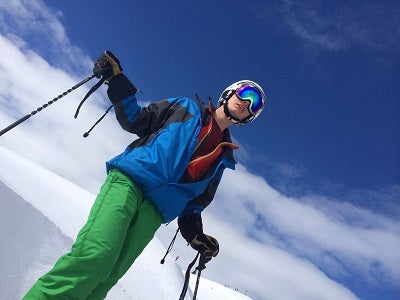
I started writing online for my own outdoor sports blog in 2010. Right out of the gate I landed opportunities to test gear for Road ID, Hydrapak, Wolverine, Helle Knives, Pearl Izumi, and GU Energy. Those were the days when growing a no-name blog was easy. Today niche blogging is a different story.
In 2012 I left Central Wyoming College with a degree in Outdoor Education and Leadership. Soon after, I was on a month-long expedition with the National Outdoor Leadership School’s Outdoor Educator Course which helps would-be outdoor guides ascend from “aspiring” to “inspiring”.
Between here and there I’ve participated in and spoken at length about outdoor pro-deal programs for companies like Patagonia, Smith Optics, Giro, Therm-a-Rest, Platypus, MSR, Columbia, and many more. I still work closely with tons of outdoor gear companies to review and analyze products. If you have a product opportunity you’d like to discuss, please review my guidelines and contact me here.
After several seasons of guiding backpacking trips and working as a certified Alpine Ski Instructor at Deer Valley Resort in Park City, UT for several seasons, I had to move on. As any educator will tell you – teaching doesn’t pay the bills very well.
In 2016 I began building my freelance writing career as readers and other bloggers reached out to me for help with technical outdoor sports content strategy for online businesses. Within weeks I was overloaded with requests for freelance writing and my new career blossomed.
2018 saw the launch of Hike With Less, my ultralight backpacking partnership program with Dustin Walker.
How to Choose the Best Skis for Beginners
- Length
- Style
- Measurements
- Mistakes to Avoid
- Learning from Friends
- Buying The Most Expensive Gear
- FAQ For Beginner Skis
- Best Ski Brands
- Conclusion
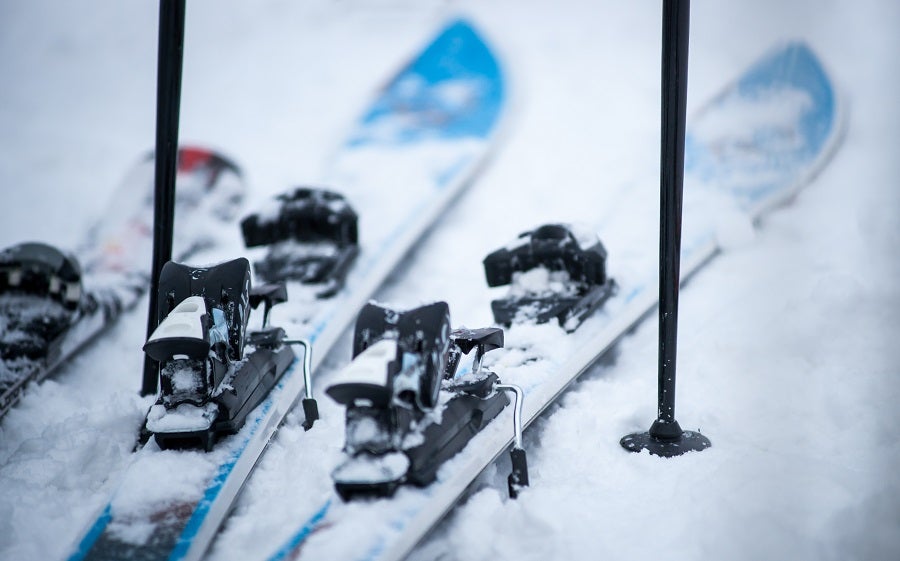
There’s a lot to learn and understand when it comes to picking out a great ski. For beginners, however, the work doesn’t need to be difficult. To get started we really only need to pay attention to a few factors when choosing a ski. Here they are, broken down for you.
Length
Choosing a ski length is pretty easy for a beginner skier. By measuring the distance from your chin to the ground in centimeters, you’ll have a great estimate of how long a ski you need as a beginner. Of course, this is a rule of thumb and won’t always hold perfectly true as there are many factors affecting ski length.
This great guide at Evo.com is an excellent starting point.
Choosing a ski which is slightly shorter than the suggested ski length for your height may help you learn to manage the ski more easily. As long as you’re staying on the groomed runs, and I hope you are when first starting out, then you won’t have an issue with a short and narrow ski.
I, personally, tend to prefer a ski which is slightly on the short end of my range for the added agility, control, and deftness of turns. If you’re particularly heavy for your height, consider a slightly longer ski.
Style
For the beginner skier (if you’ve never skied before) you’re best sticking with a beginner carving ski. Why? Because these skis are made to help a new skier learn the fundamentals of skiing as easily as possible.
Exotic ski types such as twin tips, park skis, powder skis, or other variations may not be an appropriate choice. These skis can actually make it much harder to learn good technique as a beginner skier.
Beginner skiers should pick a soft flex ski with a narrow waist for easy turning. Until you’ve mastered a handful of essential skills, you won’t be adventuring through the trees or off into the powder so using a powder ski is senseless for a beginner.
Measurements
Skis are measured in a standard way as follows:
120/88/113
Of course, this is just an example but let’s break down these numbers. First (120) is the width of the tip of the ski in millimeters. Second (88) is the width of the ski in the middle, again in millimeters. Lastly (113), and again in millimeters, is the width of the tail of the ski.
For the beginner skier, it’s pretty simple to find a ski with appropriate measurements. Look for a ski with a waist measurement (the 88 in our example) between 70mm and 85mm. It’s really that easy.
Going too wide under foot will make it harder to master new skills. Go any narrower than 70mm under foot and you’re looking at very specific race skis.
Mistakes to Avoid
As a beginner skier, there are tons of pitfalls that might cause your love of skiing to be sidelined. I’m going to make a few suggestions to help you succeed as a beginner skier while maximizing your enjoyment of the mountain.
Learning from Friends
The first time I ever went skiing my friend showed me how to pizza wedge, left me at the tow rope, and disappeared for the day. I’m still not sure how I survived that experience but I went on to fall in love with skiing.
Video: Learning to ski “Pizza” turns.
One of the biggest mistakes I see people make in skiing is trusting their friends to teach them. This so often leads to pressure, dangerous situations, and lack of true learning for the new skier.
Don’t let your friends teach you how to ski – go and get a lesson or at least ski one on one with a friend who is an instructor.
Getting started skiing the wrong way can derail what would otherwise be a potentially lifelong love affair with a wonderful sport.
Buying The Most Expensive Gear
Getting started skiing is expensive no matter how you approach it. Unfortunately, the sport is just pricey! However, the beginner skier can get away with saving a huge sum of money by moderating expenses up front.
If you start out by purchasing expert level skis and boots will only hinder your learning at the beginning. Start with a quality pair of beginner skis, they will last you many seasons on the slopes if you take care of them.
FAQs For Beginner Skis
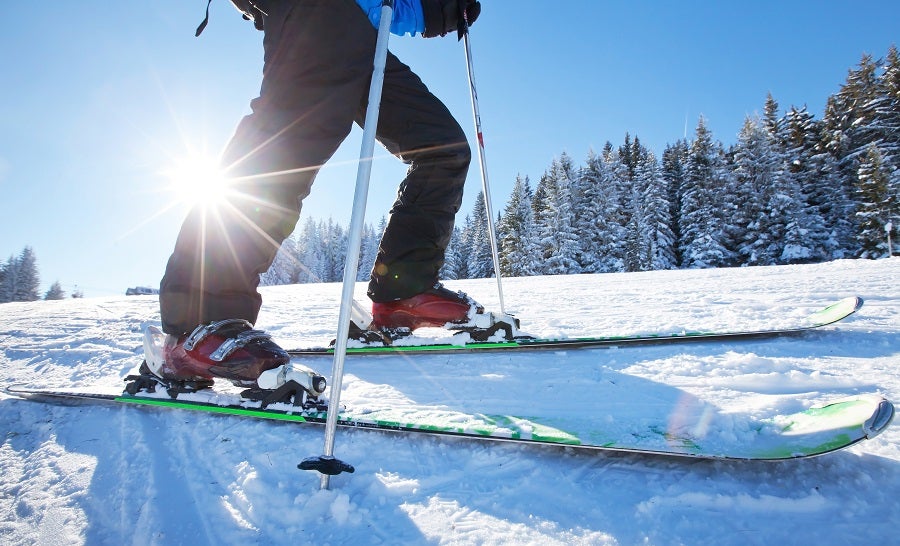
Q: What is ski stiffness?
A: Stiffness is a measure of how hard it is to flex a ski or bend it. There’s no single number assigned to this value but instead you’ll head people talk about it as sort of an empirical feeling.
Stiff skis are hard to bend and have tons of power. They’re great for advanced and expert skiers who want to really load up their turns and explode through them. This skis are common for racing and GS skiing.
Soft skis bend more easily. They really want to bend into the shape of the turn and they’re easy to initiate and exit an edged turn with. These are good for beginners who haven’t fully mastered the fine motor control and explosive power of high end skis.
Q: Should I get skis with bindings or buy the bindings separate?
A: Get your skis as a package with bindings included!
Buying separate bindings is a pain in the ass and requires that you fully understand all the details of your skis, your bindings, your boots, your skiing style, etc. Don’t do it unless you’re an expert looking for something very specific.
Today almost all major ski brands come with included bindings that are appropriately and safely matched to the ski. This means they’re going to function properly and release on time to save you from injury (or at least reduce the probability).
You’ll likely still need a ski shop to install the included bindings and set the up properly, but that’s no big deal. Usually this will cost $20-$40 and takes an overnight stay with the ski tech.
Q: What size turn radius is good for beginners?
A: I always recommend as small as possible. A good narrow waisted ski should be able to rip a 11-13m turn.
Learning to ski on a fat ski with poor turn radius usually means the ski will be lacking other characteristics that are important for developing good skills as a beginner.
It is totally possible to be a great skier on fat powder boards, but too many beginners start there without ever developing a rounded set of skills to properly control their skis.
Skis with smaller turn radius tend to be more agile and easier to control once you master the various aspects of managing your ski. If you get into hard pack or ice a narrow waisted ski will be easier to bite in and stay safe as well.
Q: Should I go with a twin tip or directional ski?
A: As a beginner there are a few aspects to consider.
Twin tip skis tend to have shorter “effective edge” meaning the tail of the ski turns up earlier. That makes turns easier to exit so you can roll into the next one without getting stuck railing the tail of the ski.
However, less edge means less control on groomed runs where most beginners will spend the majority of their time for a while. Plus, you won’t really be skiing switch (backwards) for quite a while as a beginner so twin tips are really not necessary.
The exception to this is that if you’re a beginner skier and you only want to ski park you could start with twin tips. You’ll need twin tips in the park so you might as well start with them, right?
Q: What ski length is good for a beginner?
A: Because long skis are harder to control and learn with I recommend shorter than average skis. Most people will tell you to go with skis that are about as tall as your chin to your nose. I will tell you to go with skis that are about as tall as your collarbone.
Long skis are more stable at high speeds and have more float in deep snow like powder. But, as a beginner, you won’t be doing either of those things. That’s why shorter skis make much more sense for beginners.
The only drawback to this is that you’ll eventually want a longer pair of skis. For that reason you can buy your first pair of skis used to save money, or rent skis a few times before you eventually buy longer ones.
Once you’ve gotten past the beginner stages I usually recommend chin length skis unless you plan to do a lot of skiing off-piste.
Best Brands of Beginner Skis
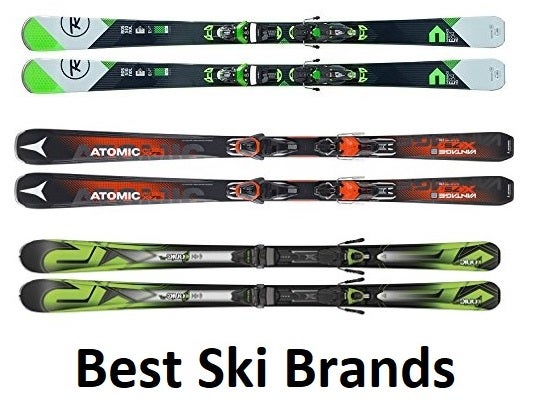 As you can imagine choosing the “best” ski brands is subjective and depends on who you ask and their level of skiing ability. However, skiing for quite some time and trying many brands of skis, I can recommend the following:
As you can imagine choosing the “best” ski brands is subjective and depends on who you ask and their level of skiing ability. However, skiing for quite some time and trying many brands of skis, I can recommend the following:
Atomic – An Austrian company founded in 1955, so they have been making skis for quite some time. One of the larger manufactures, they have a wide range of beginner to racing skis.
K2 – Founded in 1962 by Robert Marcovitch in Seattle Washington, K2 was one of the originators of modern fiberglass skis. K2’s are used by many Olympic skiers but they have a excellent lineup of beginner skis.
Rossignol – This French company has been around for over 100 years and is now the largest manufacturer of skis in the world. They are a brand you can trust and their “Experience” lineup of skis is a good choice!
Conclusion
Getting started skiing is all about having fun, mastering vital skills, and making your experience on the mountain as positive as possible.
For those reasons, I’ve outlined the best ways to get started choosing a beginner ski. Remember to avoid spending too much and take the time to learn proper skiing skills and technique so your skiing can be enjoyable, safe, and productive.
We’re looking for a specific set of criteria for a good beginner ski but the details aren’t too important. It’s far more important to get out there, take a lesson, and practice those critical skiing skills you’ll want to master!
Generally, a short ski, with a narrow waist and a low flex is a great choice for the beginner skier. If you follow this rough guideline, you’ll be certain to end up with a ski you can learn easily on.
I hope this guide was helpful in picking the best skis for beginners to fit your needs. If you want to comment or recommend a pair of skis I didn’t include, please use my contact form to get in touch.
New to skiing? See my beginners guide to skiing for tips and advice.
Have fun and be safe out there!
How We Researched
To come up with the best beginner skis, we researched a variety of sources for reviews such as REI, Backcountry, Moosejaw, EVO along with our own personal experience.
We also consulted online magazines for product research and reviews to get as much unbiased information as we could. To help weed out fake reviews we used Fakespot.com to make sure we only looked at genuine reviews.
With so much quality gear available, we had to narrow it down based on what we felt were the best options were for the price. The author, Casey Fiedler was a full-time ski instructor for Park City and The Canyons in Utah.
To help narrow down the selection he used his personal experience along with recommendations from fellow ski instructors.
After extensive research, we came up with our list to help you choose the right one for you.
Sources
